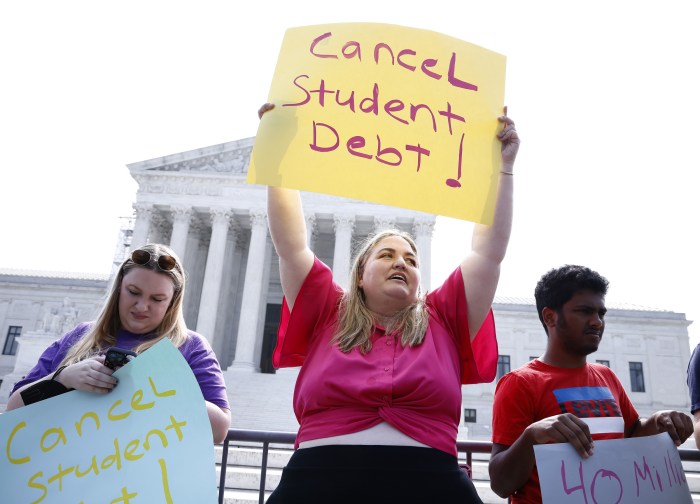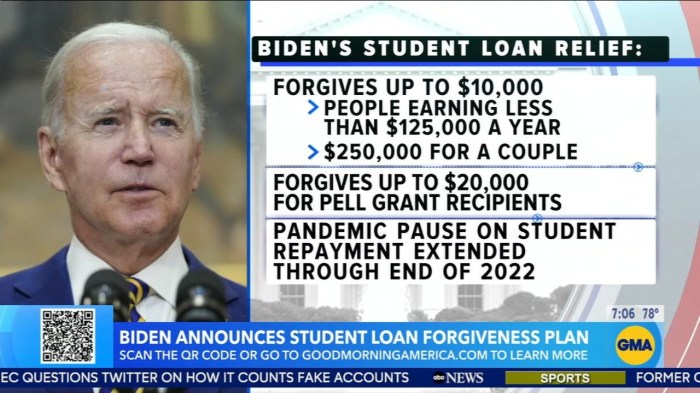
Navigating the complexities of student loan repayment can feel overwhelming. The length of your repayment journey isn’t a fixed number; it depends on a multitude of factors, from your loan amount and interest rate to the repayment plan you choose and even unforeseen life events. Understanding these variables is crucial to developing a realistic repayment strategy and achieving financial freedom sooner rather than later. This guide will explore the various repayment options available, helping you make informed decisions about your student loan debt.
We’ll delve into standard repayment plans, income-driven repayment plans (IDRs), and loan forgiveness programs, examining their eligibility criteria, payment calculations, and overall repayment timelines. We’ll also discuss the impact of factors like interest capitalization, deferment, and forbearance on your repayment journey. Finally, we’ll consider the option of refinancing your loans and how it might affect your monthly payments and overall repayment period.
Standard Repayment Plans
Standard repayment plans offer a straightforward approach to paying back federal student loans. The length of the repayment period isn’t fixed; instead, it’s determined by the total loan amount and the applicable interest rate. Higher loan balances and higher interest rates generally result in longer repayment periods. Understanding the implications of different repayment schedules is crucial for effective financial planning.
The standard repayment plan typically spans 10 years, though it can be shorter or longer depending on the loan amount. Payments are fixed monthly, and the exact amount depends on the loan principal, interest rate, and the length of the repayment period. Consistent, on-time payments are key to staying on track and avoiding penalties and increased overall costs.
Standard Repayment Plan Examples
The following table illustrates potential repayment schedules for various loan amounts, assuming a 10-year repayment plan. These are examples only and actual payments will vary based on individual loan terms and interest rates. It’s important to consult your loan servicer for your precise repayment schedule.
| Loan Amount | Monthly Payment (Estimate) | Total Paid (Estimate) | Total Interest Paid (Estimate) |
|---|---|---|---|
| $20,000 | $212 | $25,440 | $5,440 |
| $40,000 | $424 | $50,880 | $10,880 |
| $60,000 | $636 | $76,320 | $16,320 |
Impact of On-Time versus Late Payments
Making on-time payments is paramount to adhering to the standard repayment plan’s timeline. Consistent on-time payments ensure that your loan progresses according to schedule, and you avoid the added burden of late payment fees. Late payments can significantly impact your repayment timeline. They can lead to increased interest accrual, potentially extending the repayment period and ultimately increasing the total amount paid. Furthermore, late payments can negatively affect your credit score, impacting your ability to secure loans or other financial products in the future. Conversely, consistently making on-time payments demonstrates responsible financial behavior, which can positively influence your credit score.
Income-Driven Repayment Plans (IDR)

Income-Driven Repayment (IDR) plans offer an alternative to standard repayment, tailoring monthly payments to your income and family size. Several different IDR plans exist, each with its own eligibility requirements and calculation methods. Understanding these nuances is crucial for choosing the plan that best suits your individual financial circumstances.
IDR plans are designed to make student loan repayment more manageable, particularly for borrowers with lower incomes. They generally result in lower monthly payments than standard repayment plans, but often extend the repayment period, potentially leading to higher total interest paid over the life of the loan. The trade-off between lower monthly payments and a longer repayment term is a key consideration for borrowers.
Types of IDR Plans and Eligibility
Several federal IDR plans are available, including Income-Based Repayment (IBR), Pay As You Earn (PAYE), Revised Pay As You Earn (REPAYE), and Income-Contingent Repayment (ICR). Eligibility criteria vary slightly between plans, but generally require borrowers to have federal student loans and be enrolled in a qualifying repayment plan. Specific requirements might include the type of loan, the date the loan was disbursed, and the borrower’s income level. Some plans may have additional requirements based on the borrower’s family size or employment status. It’s essential to check the specific eligibility criteria for each plan on the official government website.
IDR Plan Payment Calculations and Repayment Times
The monthly payment calculation for each IDR plan differs. While all consider your adjusted gross income (AGI) and family size, the formulas and resulting payment amounts vary.
Key differences among the plans are:
- IBR: Calculates payments based on your AGI, family size, and loan balance. The repayment period can be up to 25 years.
- PAYE: Calculates payments at 10% of your discretionary income. The repayment period can be up to 20 years.
- REPAYE: Calculates payments at 10% of your discretionary income, but also considers the total amount of your student loans. The repayment period is typically 20 or 25 years.
- ICR: Uses a formula that considers your AGI, family size, and loan balance. The repayment period can be up to 25 years.
It’s important to note that the “discretionary income” mentioned in PAYE and REPAYE is calculated by subtracting 150% of the poverty guideline for your family size from your AGI. This means that borrowers with lower incomes will generally have lower monthly payments under these plans.
Impact of Income and Family Size on Repayment
Both income and family size significantly influence your monthly payment and overall repayment timeline under an IDR plan. A higher income generally leads to higher monthly payments, while a larger family size may result in slightly lower payments due to the adjusted AGI calculation. For example, a single borrower with a high income might have a significantly higher monthly payment than a borrower with a similar income but a larger family. Conversely, a lower-income borrower with a large family might qualify for a very low monthly payment, but potentially face a much longer repayment period. The specific impact varies depending on the chosen IDR plan and the individual’s financial situation.
Loan Forgiveness Programs
Student loan forgiveness programs offer the potential for complete or partial cancellation of federal student loan debt under specific circumstances. These programs are designed to incentivize borrowers to pursue careers in public service or address specific societal needs. Understanding the eligibility criteria and application processes is crucial for those hoping to benefit from these opportunities.
Eligibility requirements for federal student loan forgiveness programs vary depending on the specific program. However, common threads often include the type of loan (generally only federal loans qualify), the type of employment (typically involving public service), and the consistent fulfillment of specific repayment requirements over a defined period.
Public Service Loan Forgiveness (PSLF) Program Requirements
The Public Service Loan Forgiveness (PSLF) program is perhaps the most well-known federal loan forgiveness program. To qualify, borrowers must work full-time for a qualifying government or non-profit organization. They must also make 120 qualifying monthly payments under an income-driven repayment plan. These payments must be made on time and consecutively. Importantly, the type of loan and the repayment plan are strictly defined within the program’s guidelines. Failure to meet all criteria will result in ineligibility for forgiveness. For example, a teacher working for a public school system would likely qualify, while a teacher at a private school might not, depending on the school’s non-profit status.
Professions Eligible for Loan Forgiveness
Numerous professions qualify for loan forgiveness programs, largely those focused on public service. These include, but are not limited to, teachers, nurses, social workers, and members of the military. The specific requirements and eligibility vary based on the program and the employing organization. For instance, a nurse working at a federally qualified health center might qualify for forgiveness under certain programs, whereas a nurse working in a private practice might not. The timeline for forgiveness typically involves 10 years of qualifying payments for programs like PSLF, although other programs may have different timelines.
Applying for Loan Forgiveness: A Flowchart
The application process for loan forgiveness can be complex. The following flowchart Artikels the general steps:
[Imagine a flowchart here. The flowchart would begin with a box labeled “Am I eligible for a loan forgiveness program?” This would branch to “Yes” and “No.” The “No” branch would end. The “Yes” branch would lead to a box labeled “Choose the appropriate program.” This would lead to a box labeled “Meet all program requirements (e.g., employment, payment count).” This would branch to “Yes” and “No.” The “No” branch would lead to a box labeled “Continue making payments and re-evaluate eligibility.” The “Yes” branch would lead to a box labeled “Complete and submit the application.” This would lead to a box labeled “Application Review and Processing.” This would lead to a box labeled “Loan Forgiveness Granted/Denied.” The “Denied” branch would lead to a box labeled “Appeal or re-evaluate eligibility.” The “Granted” branch would end.]
The flowchart visually represents the sequential steps, highlighting the importance of verifying eligibility before proceeding. Each step requires careful attention to detail and adherence to program guidelines.
Factors Affecting Repayment Length
Understanding the factors influencing student loan repayment duration is crucial for effective financial planning. Several elements, some controllable and others not, significantly impact how long it takes to become debt-free. This section will explore these key factors in detail.
Interest Capitalization
Interest capitalization occurs when accrued interest on your loan is added to the principal balance. This effectively increases the amount you owe, lengthening your repayment timeline and ultimately increasing the total cost of your loan. For example, if you have a $10,000 loan with a 5% interest rate and a six-month grace period, the interest accrued during that grace period will be added to your principal balance. This larger principal balance will then accrue more interest over the life of the loan, leading to a longer repayment period and higher total payments. The longer you defer or forbear payments (discussed below), the more significant the effect of interest capitalization will be.
Impact of Deferment and Forbearance
Deferment and forbearance are temporary pauses in your loan repayment, but they come at a cost. While they provide short-term relief, they often lead to a longer repayment period. During deferment or forbearance, interest usually continues to accrue on subsidized loans and, in most cases, unsubsidized loans. This accrued interest is then capitalized at the end of the deferment or forbearance period, increasing the principal balance and extending the repayment schedule. A borrower might choose deferment or forbearance due to unemployment or financial hardship. However, it’s crucial to understand that this temporary reprieve can result in a significantly longer repayment period and increased overall loan costs. The length of the deferment or forbearance period directly correlates to the increased repayment time.
Borrower-Controlled Factors for Shorter Repayment
Several factors are within a borrower’s control to potentially shorten their repayment timeline. Making proactive choices in these areas can significantly impact the overall repayment duration and total interest paid.
- Higher Payments: Making payments that exceed the minimum required amount will significantly reduce the loan’s lifespan. Even small increases in monthly payments can make a substantial difference over time.
- Bi-weekly Payments: Paying half your monthly payment every two weeks simulates making an extra monthly payment each year, accelerating repayment.
- Additional Lump-Sum Payments: Whenever possible, making extra lump-sum payments, such as tax refunds or bonuses, can drastically reduce the loan’s overall term.
- Refinancing: If interest rates fall, refinancing your loans at a lower rate can reduce your monthly payment and shorten the repayment period. However, carefully consider any fees associated with refinancing.
- Consolidation: Consolidating multiple loans into a single loan can simplify repayment and potentially secure a better interest rate, though this isn’t always guaranteed to shorten the repayment time.
Refinancing Student Loans

Refinancing student loans can be a strategic move to potentially lower your monthly payments and shorten your repayment timeline. However, it’s crucial to understand the nuances involved, particularly when considering refinancing federal loans with private lenders. This section will explore the advantages and disadvantages of this process, providing examples to illustrate the potential impact on your repayment journey.
Refinancing federal student loans with a private lender involves replacing your existing federal loans with a new private loan. This new loan typically offers a fixed or variable interest rate, potentially lower than your current rate, resulting in reduced monthly payments and faster repayment. However, it comes with significant trade-offs, primarily the loss of federal loan benefits such as income-driven repayment plans and potential loan forgiveness programs.
Comparison of Refinancing Federal Student Loans with Private Lenders
The decision to refinance federal student loans should be made carefully, weighing the potential benefits against the drawbacks. A lower interest rate and monthly payment are attractive incentives, but losing access to federal loan benefits could be a considerable disadvantage depending on your individual financial circumstances.
Examples of Refinancing Impact
Let’s illustrate the potential impact of refinancing with a hypothetical example. Suppose a borrower has a $50,000 federal student loan with a 6% interest rate, resulting in a 10-year repayment plan. If they refinance with a private lender at a 4% interest rate, the impact on their monthly payments and total repayment time can be substantial.
| Original Loan | Refinanced Loan | Monthly Payment Difference | Total Repayment Time Difference |
|---|---|---|---|
| $50,000, 6% interest, 10-year repayment | $50,000, 4% interest, 8-year repayment (example) | Approximately $100-$200 less per month (This is an approximation and depends on the exact terms of the loan.) | 2 years |
*Note: The figures presented are illustrative examples and actual results will vary based on individual loan terms, interest rates, and lender specifics.*
Comparing Refinancing Offers from Different Lenders
Obtaining multiple offers from different private lenders is crucial to secure the most favorable terms. The process involves providing your financial information to each lender, who will then provide a personalized quote. Carefully compare interest rates, fees, repayment terms, and any other associated costs before making a decision. Consider factors like credit score, income, and debt-to-income ratio, as these will influence the interest rate offered. A higher credit score typically translates to a lower interest rate. It is also important to carefully review the terms and conditions of each loan offer, paying close attention to any prepayment penalties or other potential hidden fees. Don’t hesitate to ask lenders clarifying questions about their offerings. This comprehensive comparison will empower you to make an informed decision that aligns with your financial goals.
Visual Representation of Repayment

Understanding student loan repayment can be challenging, but visualizing the process significantly improves comprehension. Visual aids effectively demonstrate the impact of different repayment plans on both the timeline and the overall cost. This section explores effective ways to represent student loan repayment visually.
Visual representations can greatly simplify the complexities of student loan repayment. By using appropriate charts and graphs, borrowers can quickly grasp the key aspects of their repayment journey, from initial loan balance to final payment. This allows for informed decision-making regarding repayment plan selection.
Repayment Timeline Visualization
A typical repayment timeline can be illustrated using a line graph. The x-axis represents time (in months or years), and the y-axis represents the outstanding loan balance. The line itself would show the gradual decrease in the loan balance over time. Key milestones, such as the point where principal repayment begins to significantly outweigh interest payments, could be marked. Different colored lines could represent different repayment plans (e.g., Standard, IDR), illustrating how their varying payment amounts affect the repayment duration. The area between the line and the x-axis could be shaded to represent the total interest paid over the life of the loan, visually highlighting the impact of interest accrual on the total cost. A steeper downward slope would indicate faster repayment, while a shallower slope would indicate slower repayment.
Comparison of Total Repayment Costs
A bar graph is ideal for comparing the total repayment cost under different repayment plans. Each bar would represent a specific repayment plan (Standard, IDR plans, etc.), with its height corresponding to the total amount repaid (principal + interest). The difference in bar heights would clearly demonstrate the financial implications of choosing one plan over another. For added clarity, labels could indicate the total amount repaid for each plan, as well as the total interest paid. This visual allows for immediate comparison of the long-term financial consequences of each repayment option. For example, one bar might represent a Standard Repayment Plan showing a total repayment of $50,000, while another bar for an Income-Driven Repayment Plan might show a total repayment of $70,000 over a longer period. The difference in bar height would instantly show the cost difference, even though the IDR plan might have lower monthly payments.
Conclusive Thoughts
Successfully managing student loan repayment requires careful planning and a proactive approach. By understanding the different repayment options available, the factors that influence repayment length, and the potential benefits and drawbacks of refinancing, you can create a personalized strategy that aligns with your financial goals. Remember to regularly review your repayment plan and adjust it as needed to ensure you stay on track towards becoming debt-free. Proactive management and informed decision-making are key to navigating this significant financial undertaking successfully.
Frequently Asked Questions
What happens if I miss a student loan payment?
Missing payments can lead to late fees, damage your credit score, and potentially accelerate the total amount you owe due to accruing interest.
Can I consolidate my student loans?
Yes, consolidation combines multiple loans into one, potentially simplifying repayment. However, it might not always shorten the repayment period or lower your interest rate.
Are there penalties for paying off my student loans early?
Generally, there are no penalties for early repayment, but always check your loan agreement to be sure.
How often are my student loan payments due?
Typically, student loan payments are due monthly.
